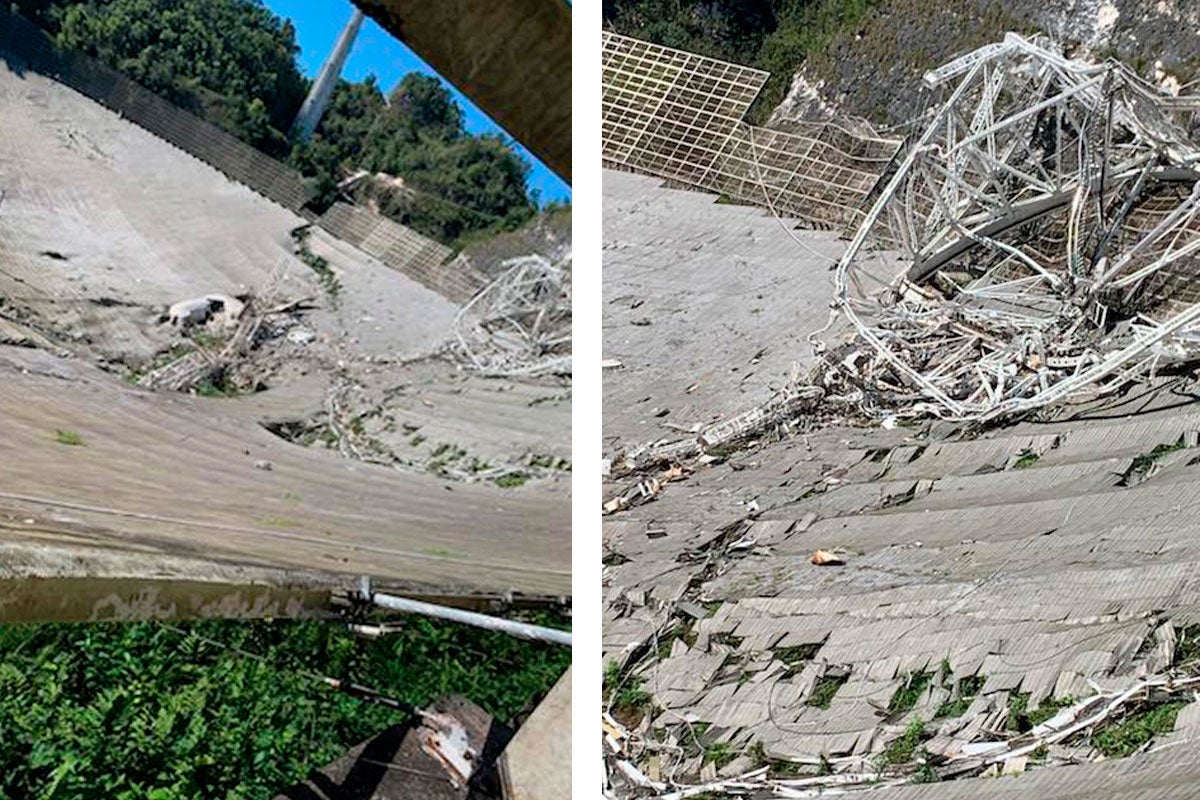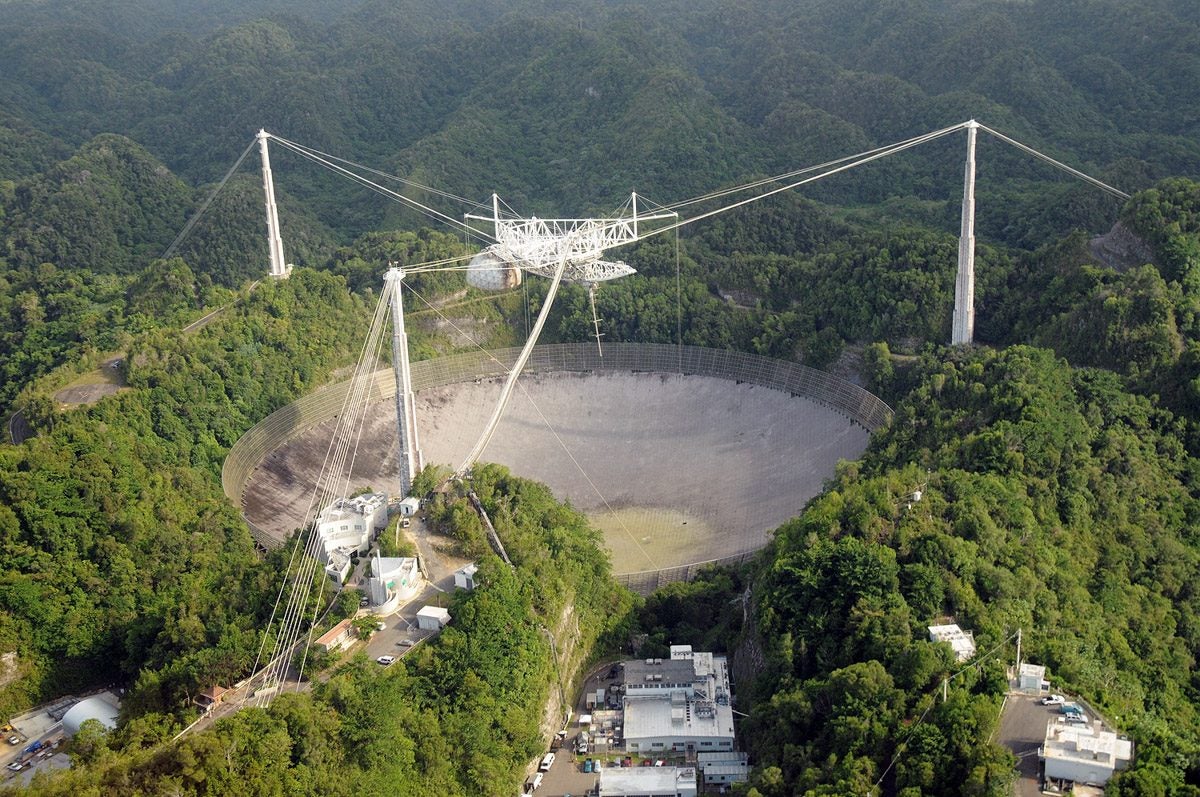The instrument platform of the 305-meter telescope at Arecibo Observatory in Puerto Rico fell at approximately 7:55 a.m. Puerto Rico time today, Dec. 1.
No injuries were reported as a result of the collapse, but it caused damage to the observatory dish and surrounding facilities. Extent of the damage is being assessed.
“Safety of personnel is our number one priority. We already have engineers on site to help assess the damage and determine the stability and safety of the remaining structure.”
— Elizabeth Klonoff
The National Science Foundation had ordered the area around the telescope to be cleared of unauthorized personnel for the past month. Local authorities will keep the area cordoned off as engineers work to assess the stability of the observatory’s other structures.
“We knew this was a possibility, but it is still heartbreaking to see,” says Elizabeth Klonoff, vice president for research at UCF, which manages the facility for the NSF. “Safety of personnel is our number one priority. We already have engineers on site to help assess the damage and determine the stability and safety of the remaining structure. We will continue to work with the NSF and other stakeholders to find ways to support the science mission at Arecibo.”
The top priorities will be maintaining safety at the site, conducting a complete damage assessment as quickly as possible, and taking action to contain and mitigate any environmental damage caused by the structure or its materials. While the telescope was a key part of the facility, the observatory has other scientific and educational infrastructure that NSF will work to bring back online.
“We are saddened by this situation but thankful that no one was hurt as a result,” said NSF Director Sethuraman Panchanathan. “When engineers advised NSF that this structure was unstable and presented a danger to work teams and Arecibo staff, NSF took their warnings seriously and worked to make sure that we were prepared for this outcome. Our focus is now on assessing the damage, finding ways to restore other parts of the observatory to operations and working to continue supporting the scientific community and people of Puerto Rico.”

The investigation into the exact details of the platform’s fall is still ongoing. Initial findings indicate that the top section of all three of the 305-meter telescope’s support towers broke off and landed outside the area of the dish. As the 900-ton instrument platform fell, the telescope’s support cables also dropped. The Gregorian Dome is in the dish and the platform is lying on the edge of another side of the dish.
The observatory’s learning center, located near Tower 12, appeared to sustain heavy damage from falling cables. Although the 305-meter telescope dish sustained heavy damage, parts remain intact.
Working with UCF, NSF expects to have environmental assessment workers on site as early as today, Dec. 1. Workers at the observatory will wear appropriate safety gear while a full assessment of the site’s safety is underway.
NSF will continue to authorize UCF to pay Arecibo staff and take actions such as repairing the observatory’s 12-meter telescope and the roof of its LIDAR facility, a valuable geospace research tool. UCF has received several grants from NSF as part of the management cooperative agreement.
The observatory, completed in 1963, was home to one of the most powerful telescopes on the planet. Its instruments are used by scientists around the world to conduct research in the areas of atmospheric sciences, planetary sciences, radio astronomy and radar astronomy. The telescope has contributed to significant breakthroughs in space research in the area of gravitational waves, asteroid characterization, planetary exploration and more. Arecibo is also home to a team that runs the Planetary Radar Project supported by NASA’s Near-Earth Object Observations Program in NASA’s Planetary Defense Coordination Office through a grant awarded to UCF.
Cable Background
Although the platform’s fall was unplanned, NSF, UCF and other stakeholders, including three engineering firms had been monitoring developments at the 305-meter telescope that indicated an increased risk of a collapse.
In August, one of the 305-meter telescope’s cables unexpectedly detached. The remaining cables were expected to bear the load without issue as engineers worked on plans to address the damage. However, a second cable broke Nov. 6. Engineers subsequently found the second snapped at about 60% of what should have been its minimum breaking strength, indicating that other cables may be weaker than expected, and advised that the structure cannot be safely repaired.
Both cables were attached to the same support tower. If the tower lost another cable, the engineer company leading the efforts said, an unexpected collapse would be the likely result. Since NSF announced its plan to pursue decommissioning Nov. 19, surveillance drones found wire breaks on two additional cables attached to the same tower.
One showed between 11-14 broken exterior wires as of Nov. 30 while another showed about eight. Each cable is made up of approximately 160 wires. Engineers could not determine whether any internal wires have broken prior to the failure.
NSF will continue to release details as they are confirmed.




